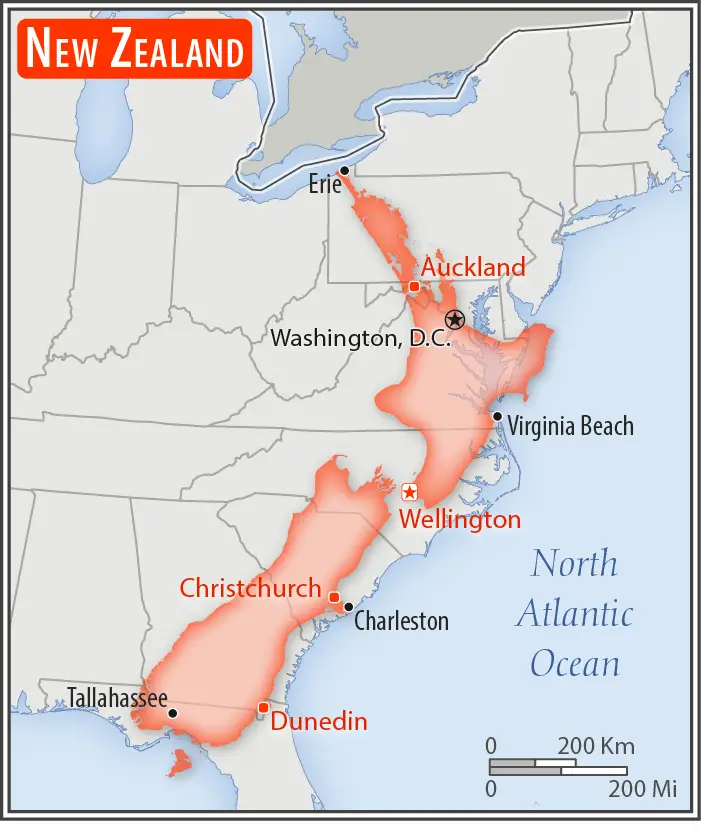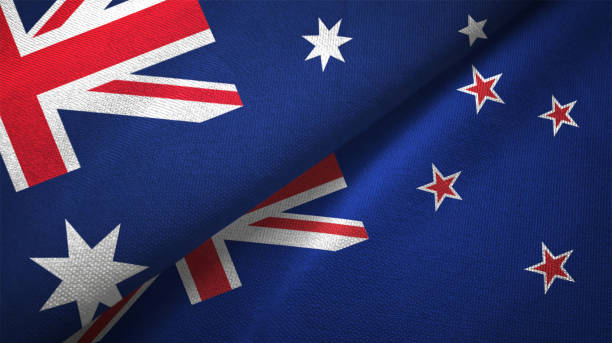Which is the biggest? How Big Is New Zealand Compared to the United States? New Zealand and the United States are two countries located on opposite sides of the world. Despite their geographic distance, they are often compared in terms of their size, population, and economic status. In this article, we will explore how big New Zealand is compared to the United States.
To start, let’s look at the land area of each country. According to the United Nations, New Zealand has a land area of approximately 268,000 square kilometers (103,483 square miles). In comparison, the United States has a land area of approximately 9.8 million square kilometers (3.8 million square miles). This means that the United States is approximately 36 times larger than New Zealand in terms of land area.
The population of each country is also an important factor to consider when comparing their sizes. According to the World Bank, as of 2020, the population of New Zealand was approximately 5.1 million people. In contrast, the United States has a population of approximately 332 million people. This means that the United States is approximately 65 times larger than New Zealand in terms of population.
The size and population of a country can have a significant impact on its economy. The United States has the largest economy in the world, with a gross domestic product (GDP) of approximately $21.4 trillion USD in 2020, according to the World Bank. In comparison, New Zealand’s GDP was approximately $200 billion USD in 2020. This means that the United States has an economy that is approximately 107 times larger than New Zealand’s.
Another important factor to consider when comparing the sizes of New Zealand and the United States is their geography. New Zealand is a group of islands located in the southwestern Pacific Ocean, while the United States is located in North America and is bordered by Canada to the north, Mexico to the south, and the Atlantic and Pacific oceans on the east and west coasts, respectively.

Due to its location, New Zealand is often subject to earthquakes and volcanic activity. In contrast, the United States experiences a wide range of natural disasters, including hurricanes, tornadoes, earthquakes, wildfires, and floods. The geography of a country can have a significant impact on its infrastructure, as well as its ability to respond to natural disasters.
In terms of political systems, New Zealand is a constitutional monarchy with a parliamentary democracy, while the United States is a federal presidential constitutional republic. Both countries have systems of government that provide for representative democracy, but they differ in terms of the distribution of power between the executive, legislative, and judicial branches.
Culturally, New Zealand and the United States have many similarities and differences. Both countries are home to diverse populations and have vibrant arts and cultural scenes. However, they differ in terms of their dominant religions, with Christianity being the most common religion in the United States and no dominant religion in New Zealand. They also differ in terms of their cuisines, with New Zealand having a strong emphasis on seafood and lamb, while the United States is known for its fast food and regional cuisine.
In conclusion, while New Zealand and the United States are both countries with diverse populations and vibrant cultures, they differ significantly in terms of their size, population, economy, geography, political systems, and cuisines. While New Zealand is a relatively small island nation located in the southwestern Pacific Ocean, the United States is a large, diverse country located in North America with the largest economy in the world. Understanding these differences is important for appreciating the unique qualities of each country and for building bridges between them.

Additionally, it is important to note that the size comparison between New Zealand and the United States can be further contextualized by comparing their individual states or territories. For instance, California, the largest state in the United States, has a land area of approximately 423,970 square kilometers (163,696 square miles), which is roughly 1.5 times larger than New Zealand’s land area. Texas, the second-largest state in the United States, has a land area of approximately 696,241 square kilometers (268,581 square miles), which is more than 2.5 times larger than New Zealand.
However, it’s worth keeping in mind that size doesn’t always equate to significance or influence. Despite its small size, New Zealand has made significant contributions in many fields, including science, technology, and culture. For instance, New Zealand has been a leader in environmental conservation and renewable energy, and it is home to many notable figures in the fields of literature, music, and film.
Furthermore, New Zealand has been recognized for its effective response to the COVID-19 pandemic, which has garnered global attention and praise. The country’s swift and decisive action, including border closures and aggressive testing and contact tracing, has resulted in one of the lowest infection rates and death tolls in the world. In contrast, the United States has faced significant challenges in responding to the pandemic, with high infection and death rates and ongoing political debates over public health measures such as mask mandates and vaccination requirements.
In summary, while the size comparison between New Zealand and the United States can provide some interesting insights, it’s important to recognize that both countries are unique and have their own strengths and weaknesses. Instead of focusing solely on size or population, it’s more valuable to appreciate the diversity, culture, and achievements of each country and the individuals who call them home.





